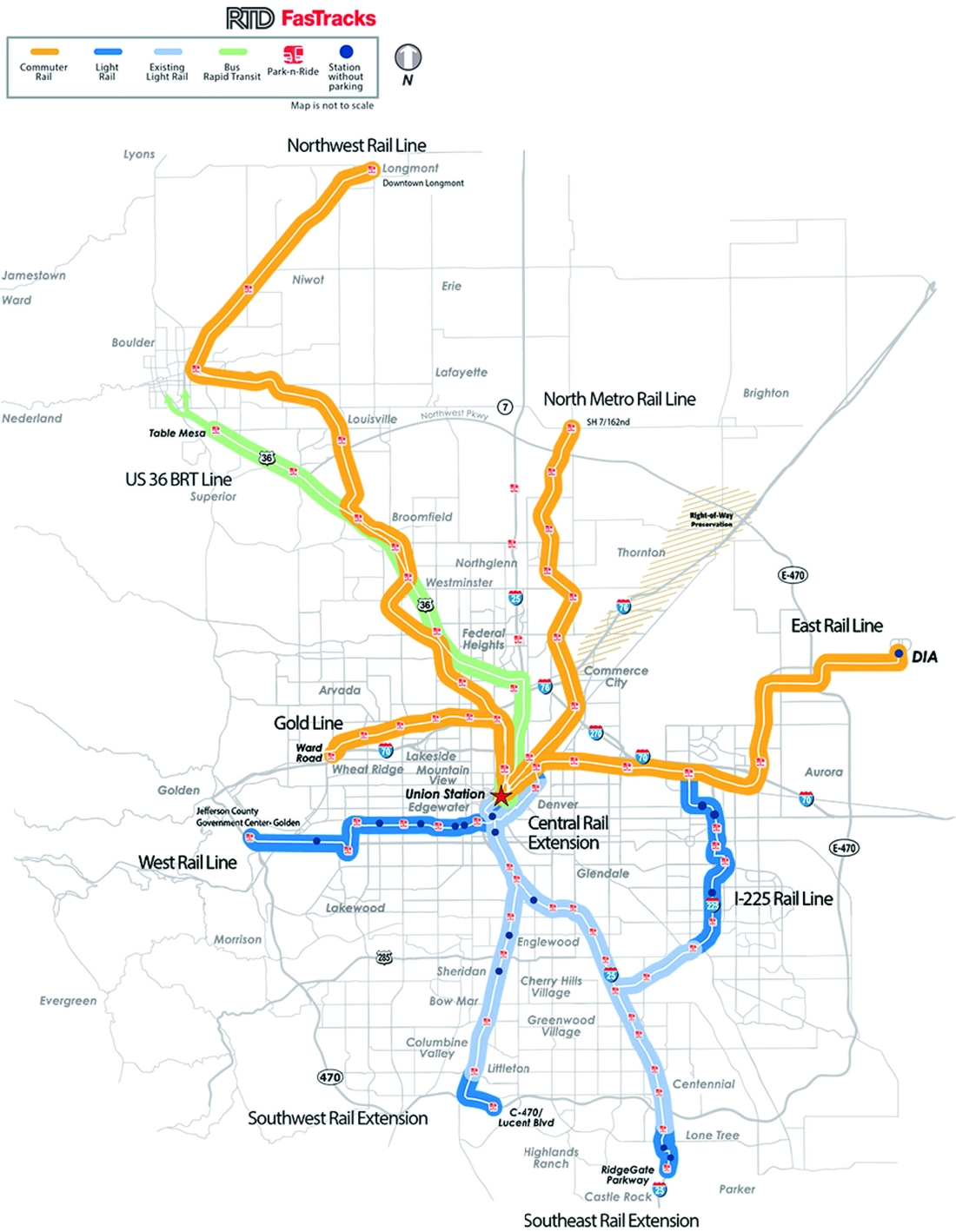Denver rail transit: Coming to a neighborhood near you

If you live in, work in, or visit the Denver metro area, here’s some good news: One of the nation’s largest rail transit systems is being built right now in the Mile High City. This is exciting news for several reasons: It will give people an alternative to driving their car; it will help decrease air pollution and the consumption of fossil fuels used by automobiles; it will help reduce congestion and the need to widen existing highways; and, it will encourage new development along rail lines that put more people living and working close to transit stations.
Let’s take a look at the past, present, and future of the build-out of Denver’s regional rail transit system:
Central Line. From I-25 and Broadway through Central Downtown to 30th and Downing, this was the starter line that served as the initial spine to the region’s rail system, opened in 1994.
Denver Union Station Extension .
A short spur off the Central Line from the Auraria Campus near Colfax to Denver Union Station, opened in 2002.
Southwest Line . From Mineral Avenue in Littleton along Santa Fe Drive, the Southwest Line arrived into Central Downtown in 2000 and Union Station in 2002.
Southeast Line . From Lincoln Avenue in Douglas County along I-25, the Southeast Line opened into Central Downtown/Union Station in 2006.
Interstate 225 Line – Segment 1 . From I-25 in the Denver Tech Center to the Nine Mile Station in Aurora, this first segment of the I-225 opened in 2006 along with the Southeast Line.
West Line . The first of the FasTracks lines to open (2013), the West Line runs from the Jefferson County Government Center in Golden to Denver Union Station via Lakewood and West Denver.
East Line . Connecting Union Station to DIA, the East Line follows I-70 and Peña Boulevard and will open in 2016.
Gold Line . From western Wheat Ridge near I-70 and Ward Road, the Gold Line goes through Wheat Ridge, Arvada, and Northwest Denver into Union Station, opening in 2016.
Interstate 225 Line – Segment 2 . Continuing from where Segment 1 stopped at the Nine Mile Station, Segment 2 continues along I-225 through Aurora and the Anschutz Medical Campus to connect with the East Line near I-70 and Peoria, opening in 2016.
Northwest Line – Segment 1 .
From Union Station, this first segment of the Northwest Line heads into Westminster, ending at 71st and Lowell and opening in 2016.
North Line – Segments 1 and 2 .
The first two segments of the North Line will run from Union Station to 124th Avenue via Commerce City, Thornton, and Northglenn, with phased openings in 2016 and 2018.
Future Extensions . Additional extensions include extending the Northwest Line past Westminster into Boulder and Longmont; extending the North Line up to 162nd Avenue; extending the Central Line from 30th and Downing to connect with the East Line; extending the Southwest Line into Highlands Ranch; and extending the Southeast Line farther south into RidgeGate.
That’s a system of about 115 miles of rail transit that will be up and running by 2018, with 30-plus more miles of extensions coming later as funding becomes available. Taking the train to work, school, a sporting or cultural event or to the bar is going to become a whole lot easier for many people in Metro Denver. It won’t be the end-all for everyone’s transportation needs — there’s no expectation of that — but what our region’s burgeoning rail system will do is give everyone more options for getting around, and make Denver a more urban, sustainable city.
What's Your Reaction?
Ken Schroeppel is a faculty member of the College of Architecture and Planning at the University of Colorado Denver. He teaches in the Master of Urban and Regional Planning program. Ken is also the founder of the DenverInfill and DenverUrbanism website and blogs, which offer aspects of sustainable design and urbanism in the Mile High City. Find them at DenverInfill.com.









